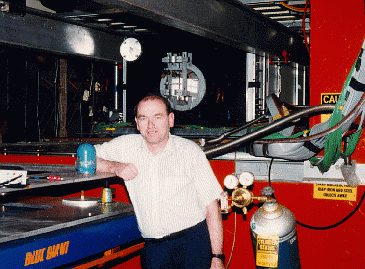Experimental Research in Nucleus-Nucleus Collisions at Kent State U
The ultimate objective of research into relativistic nucleus-nucleus (heavy
ion) collisions is to reach a level of understanding of nuclear that is
comparable to our present-day knowledge of conventional atomic matter.
As yet, we know very little about the possible states of nuclear matter.
There are indications that nuclei with little or no excitation have
liquid-like properties, and that a gaseous character becomes evident
under conditions of higher excitation. To what extent is this change,
which takes place in a system of several hundred particles at most,
similar to the phase transitions studied in condensed matter physics?
What is the relationship between pressure, density and temperature in
the excited nuclear vapor, and to what extent are these concepts even
relevant? Experiments at heavy ion accelerators in the intermediate to
high energy region allow us to address these questions. At the highest
ultrarelativistic energies, the distinction between nuclear and particle
physics becomes blurred, and the most prominent goal in nuclear collision
experiments is to search for signatures of quark-gluon plasma. Discovery
of this phase would be a major vindication of the standard unified
description of matter in terms of quarks, electron-like particles, and
the fields mediating their interactions.
Our experimental heavy ion group is supported largely by the US Department of
Energy, and in recent years has consisted of one faculty member, one Senior
Research Fellow who works part-time on this project, one full-time and one
half-time postdoc, two to three graduate students, and from time to time, an
overseas visiting scholar and an undergraduate student. Our physics analysis
effort has been focused on multiparticle correlations and particle production
using tracking detectors that intercept a large fraction of all particles
emerging from the collisions. In the area of detector development, we work
on software for tracking and particle identification, various Graphic User
Interfaces for monitoring detectors or subsystems, and simulations. In the
future, the activities of our group and that of Prof. Spiros Margetis will
converge, and we anticipate joint funding and joint advising of some or all
of our graduate advisees.

Currently, we conduct collaborative experiments at Brookhaven National
Laboratory in New York. The picture shows the 2+ million-pixel E895 Time Projection Chamber installed in
a large aperture dipole magnet. Following the recent commissioning of the
Relativistic Heavy Ion Collider (RHIC)
at Brookhaven, the main focus of our physics analysis has shifted from E895
to a large RHIC experiment utilizing a powerful general-purpose detector
system called STAR.
Large-acceptance tracking detectors for heavy-ion collisions need to
operate at the forefront of technology in data acquisition, data mining,
graphics applications and computers in general, and graduate work in this
area builds expertise in widely-applicable techniques as well as providing
an excellent training in basic physics. Students in our group have the
option to spend an extended period at a national laboratory, where
they typically divide their effort among a mix of hardware and software
projects according to their personal taste and the responsibilities of
our group. Skills can be acquired during this period that help broaden
the range of employment opportunities upon graduation.
Back to DK home
